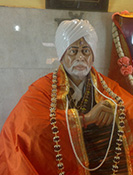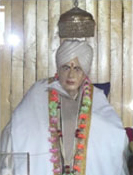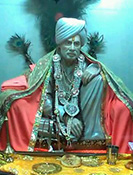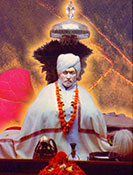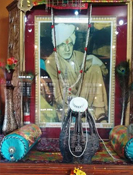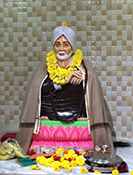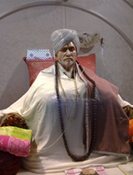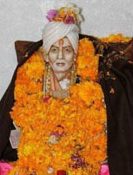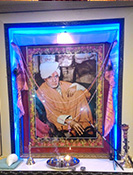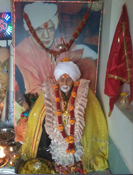SRI-CHAKRA' THE ULTIMATE
The word `Sri' means wealth and 'Yantra' an instrument. It regards as an instrument of wealth which is considered as one of the most auspicious, holy and important instruments for mankind due to the fact, that when used, it makes one remain aloof from the worldly desires. That is why saints, yogis and spiritualists use it by virtue of their devotion as an instrument to attain ultimate goal of this life by worshipping it early in the morning. On the other hand, common people mostly use it for attaining all worldly desires, wishes, wealth, prosperity, name and fame etc. and worship it early in the morning. In other words, we can say that this is the instrument of extra-ordinary energy which is very useful to those who remain aloof from the worldly desires as well as to those who remain in touch with it for want of prosperity.
No doubt, there are fifty two Sri Yantras or Sri Chakra in India as whole but the natural form or Soyambu Sri Yantra or Sri Chakra has been predominantly focused by spiritual persons as one of the most auspicious not only in India but the whole world.
In Srinagar [Kashmir] on Hari Parbhat, the abode of ahashakhati, the divine mother Jaghadamba Sharika, also known as Mahatripur Sundri or Rajrajeshwari, locally called as 'Haer' or Myna, an eighteen armed Goddess, is regarded as the present deity. She is a' Soyambu' or self made Sri Chakra or Mahashri Yantra emerged on holy rock or shilla located at it's middle western face. This is considered the main energy centre in the universe which has a great importance for attaining spiritual bliss.
Apart from mythic tale regarding the hillock, we find it as a multi-dimensional geometrical figure and at the corner of it is present Sri-Yantra or Sri-Chakra on a rock with different geometrical images and forms in the shape of triangles, squares and pentagons. If anybody sees it patiently and with due respect and consideration, he gets lost in this miracle of nature.
From time immemorial, this rock or Yantra is here and devotees revere it to the core of their heart by coating `Sindoor' on it on auspicious days due to which the figures on it are not fully visible now. May be this Yantra is a secret and that is why in Kashmir it is said SATAN SYNDRAN TAL or a secret under coating of seven sandoors. No research scholar up to this date has got ready to identify these figures on it which can through light on its origin or existence, except a Muslim painter of repute the late Gulam Rasool Santosh,who worked on it in the mid-seventies and gave a full-fledged figure of this Yantra in his masterpiece paintings. I feel that Goddess is not in favour of revealing her secrets. But devotees have faith on this Sri-Yantra and are worshipping it for the betterment of humanity as a whole from time immemorial. The present young generation takes it only as a rock and knows nothing of what is carved on it.
But we should admit that this is a foundation rock of Hindus of Kashmir and part and parcel of their cultural ethos. This rock is witness to evil and bad times through which the flowery valley of Kashmir has passed up to this date. This is also the source of evidence of the turmoil of our community which became the main source of conversion several times and migration of hapless people to plains seven times for the last six hundred years due to terror. But our community has a firm faith on this Yantra or energy centre which has a record in Nilmatpuran and Kalhan's Rajtarangni. But it is strange that no meaning is found in these authoritative books. This clearly shows that even Kalhan Pandit had no knowledge about it.
I have been able to get some facts about the carvings on this rock from different knowledgeable persons and some saints and sadhus who have keenly observed it. How far they are correct, I cannot say but I request other learned persons and intellectuals of our community through this write-up to give any more relevant facts if they have to the readers about the Yantra which has a great importance in our cultural ethos. According to some scholars the Yantra or energy centres found in the rest of the country have two dimensions where as in Kashmir it is three dimensional, the only Yantras of such nature found in whole world which has a great spiritual importance. Those who have minutely seen it have divided it into two forms ie.evolution Yantra of Kalander order of Kashmir. Above all it has nine folds, outer three cubs, which depict charkas ruling the three worlds, sixteen petals depicting sixteen Yognis associated with the attainment of desires, eight petals depicting the power of speech, holding, walking, exerting, pleasure, abandoning, concentration and detachment. Fourteen triangles describing all good fortune and associated with chief nadis and currents of Bio-energy. Ten outer triangles depicting Yognis of ten vital breathes. inner triangles depicting power often vital fires, eight triangle powers that rule cold, heat happiness, sorrow, des ire and three gunas or instincts-Sat, Rajas and Tamas. Central triangles depict chakra giving all success and the Bindu, a centre depicting Mata Tripur Sundri the ultimate. This is the meaning derived by scholars from this Sri Yantra. It is time for other high profile scholars of the country to examine and observe the Sri- Yantra minutely and give their viewpoint regarding the carvings on it. Maybe, their findings can improve on available information.
Apart from mythic tale about this sacred Yantra, we can say that Hari-Parvat hillock, on which this rock-Yantra exists, has been sacred to Hindus from time immemorial. We find a shrine-image which is called 'Chakreshwari' as per `Visshtadhbava'doctrine, 'Sri' is called the divine consort of Almighty Shiva and she is said to have plated an intermediary role between the Lord and human soul. To reach this shrine one has to go up a flight of stairs with one hundred and eight steps made of chiseled stones. Why one hundred and eight/This has a mystical significance in Hindu Mythology. Another important point which is to be noted, have is that 'Chakereshwari' is the Bindu or central point of the capital of the valley which has derived it's name from 'Sri' or beautiful as well as wealthy.
It has been called Srinagar from time-immemorial. Since then, so many kings of Kashmir established new capitals of Kashmir with new names from time to time. Avantipur of Avantiverman, Parihaspur of Lalitaditya etc. are some examples but the importance of Srinagar remained there and that is same even up to this date. The city is considered the central part of the valley of Kashmir. It is perhaps the blessings of Mata Sharika on this city.lt was developed so many times and devastated so many times but it's existence remained the same as before.
It has remained the common practice of many devotees of this supreme Goddess, especially of those living in Srinagar city, to climb one hundred and eight steps to reach the goddess in the form of Srichakra and have darshan regularly in the morning. Actually goddess have been worshipped by the devotees of the valley in particular and of the plains in general from the time it has taken the form of rock on the hillock of Hari- Parvat, but there are some specific days when the devotees throng there for performing special puja and chanting Bhajans collectively in praise of Chakreshwari for the betterment of common masses. One such auspicious day is Phalgun Krishna Paksh Ashtami which is called 'Hora-Ashtami' in Kashmir. This day has a great importance for Kashmiris. Firstly, this is a special day when Kashmiri pundits while wash their houses before Shivratri and secondly there is a belief that mother Sharika comes to this hillock from Kishtwar on this night every year. Besides this Ashad-Saptami, Ashtami and Naumi are the three main auspicious dates dedicated by Pandit devotees to Goddess Sharika and the chanting of Vedic hymns and the singing of devotional songs remains the main activity,
We must understand the fact that the Goddess came here in the form of Kali.lt is evident from the mythic tale that she killed Jalodhbava, the water demon who was living in Satisara. So she wants blood and sacrifice. Ashad Naumi is said to be birthday of Sharika and devotees throng to this hillock shrine in a large number on this day. They make sacrificial offerings of `Tahar' or rice boiled with turmeric, liver of goat to the Goddess and Kashmiris call it CHUTKHARUN. On Navreh, the first day of the year of Kashmiri Pandits according to the Bikrami calendar and on the Navratra days, special puja is performed here. Actually, her presence on this hillock is considered in the form of rock on shilla in her vertical form. The whole of Hari-Parvat is a hollowed place. The temples around it represent different deities. This is due to These temples that the devotees undertake circumambulation on the whole hillock of Hariparvat early in the morning which is called `Parikrama' in Sanskrit `Prakram' in Kashmiri. Actually, this process starts from the temple of Ganesha which has been installed on the south-west corner but the devotees have option of taking either of the two routes.
The other route is `Ishi-Sathapna' which is called 'Satrishi' marked by an open space in the shape on the slope of hillock near the big boulder in the vicinity of a Chinar tree. Here the devotees ascertain their luck which is called 'Phal' in Kashmiri by randomly by picking up rice grains scattered on the boulder.
The next spot is the temple of Kali which also adjacent to a Chinar tree. In front of the temple we find a large pond which is known as `Sidh-peeth', a place of awakened divine influence. This place has divine vibrations. Next on the parikrama route is a vast but open space called 'Devi -Angun', the playground of mother Goddess or cosmic mother. Due to its wonderful scenic beauty, this piece of land is being used for social gatherings especially on 'Navreh' the first day of the year of Kashmiri Pandits. Near it is the Sathapora of Hari represented by rock located on the north-eastern part of hillock. After bowing it here in reverence, devotees take a symbolic round parikrama in front of the shilla. Of the two routes of parikrama, one leads to kali and the other to the foothill of hillock.
The shilla or Sri-Yantra of Goddess or Chakreshwari has inspired all devotees of the country from time-immemorial. This is the place where a true devotee gets darshan of the Goddess and the recent example in this regard is of Bhagavaan Gopinath ji, the extra-ordinary saint of 20th century who has seen Goddess in the form of small girl playing in Devi Angan. He was blessed by her that has been recorded by his devotee Sh. S.N Fotedar in the biography of the saint.
Avtar Krishan Razdan
Mobile-09906010078






